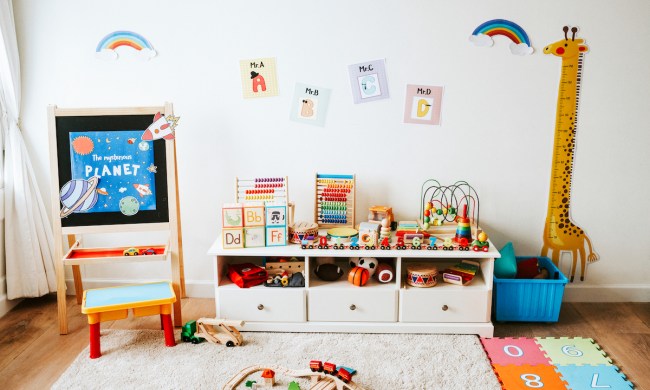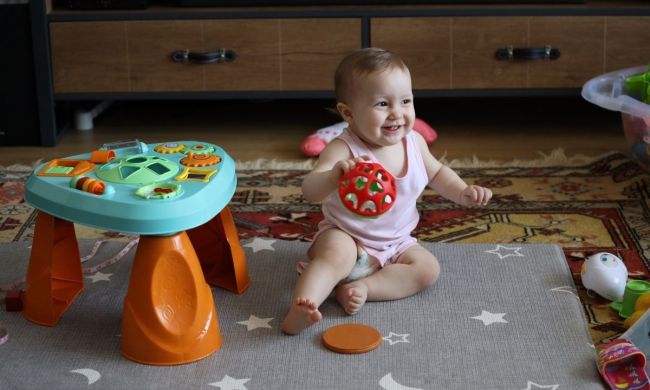Baby swings have a bit of controversy. When you read lists of things your baby doesn’t need during their first year of life, inevitably, a baby swing is among them. For some parents, this proves true. They take up space, and some babies don’t even like swings.
Before you scratch a swing off your list, we think you should reconsider this classic baby item. Swings can be lifesavers during the early months of your baby’s life for excellent reasons. Let’s take a look at a few things that will bring you back on board with this baby gear staple.
Baby swings may help during the fourth trimester
Human babies are born early. It’s an evolutionary trade-off between our narrower hips that allow us to walk upright and our larger brains. If you’ve ever wondered why human babies take so long to “wake up” to their personalities, it’s because the first few months of life are affectionately called “the fourth trimester.”

During the early weeks, babies will want to feel like they’re still in the womb. They’ll cry if they aren’t cuddled or wrapped uptight, and being alone may be terrifying. They’ve been used to the movements of their mother’s body, and sudden stillness may not sit well.
A swing can help mimic the movements of a mother’s womb. You can’t hold your baby all the time, especially if you have older children, and a swing could help calm your baby during these first few weeks.
Baby swings may encourage better naps
Babies can get overtired, just like older children (and even adults). As babies begin to “wake up,” i.e., not immediately sleeping after every meal, it could be harder to get them settled down to take their naps. And once a baby is overtired, it can be challenging to catch up.
A swing can be a useful tool for encouraging naps because the gentle movements lull the baby to sleep. Many swings also have noise settings to help soothe your baby with music or simply white noise so they don’t startle as easily.
Baby swings may also help with reflux and even colic. Keeping your baby at a safe incline could help reduce pain from reflux and encourage better digestion and breathing. Swings have harnesses that keep your baby in the correct position throughout the nap, so your baby has the best chance of quality sleep.
Swings can provide mental stimulation
Even when babies don’t seem like they understand anything around them, they’re still learning all the time. Babies need visual stimulation during the early weeks to help them learn to focus, and they need physical stimulation for motor skills.
The bright colors and hanging mobiles on most swings provide your baby with vital stimulation from the earliest parts of life. As your baby gets older, reaching for things can help with gross motor skills that become more important with each later milestone.
This entertainment plays a critical role in your baby’s mental development. Swings allow your baby to be educated and entertained even during the moments when you can’t focus your entire attention on your baby.
A swing provides stimulation to the vestibular system
A big part of early development is the vestibular system. The vestibular system provides us with cues from our body in the environment, allowing us to learn to balance, coordinate our movements, and gain spatial orientation.
Babies don’t have a well-developed sense of vestibular movement yet. Some evidence suggests that spending time in swings may allow the baby to get used to changes and provide stimulation that helps this critical system develop.
As the swing moves, babies learn to coordinate the movement of their own bodies against that of the environment. They learn to identify what is upright and may even be better able to steady their limbs as they get older. While studies aren’t definitive, it’s encouraging to see these preliminary findings.
A swing gives parents a break
If your baby had their way, you’d hold them all the time. That isn’t realistic. Parents need breaks to care for older children, take care of household needs, work, or decompress after caring for an infant. Time for yourself is essential in your mental well-being.
If your infant screams each time you put them in the crib, and you can’t just leave them on the floor or your couch, a swing could provide a safe, soothing environment for your infant while you get other things done. You know your child is secure, getting necessary mental stimulation, and maybe even napping with quality sleep.
Choosing the right swing
Choosing a swing is a big decision, so consider a few things as you’re deciding.
- Settings – swings that offer multiple settings can help you find what your infant loves. Basic swings have three speed settings (low, medium, and high), while more complex swings may have swing-pattern settings, as well.
- Power sources – A simple plug-in swing provides hours of power, but a battery option allows you to put the swing wherever you want. The best option is a swing that has both choices for versatility.
- Safety – The swing should have a harness with a lower pad that ensures the baby can’t slide down and suffocate or accidentally roll out.
Swing basics
- When can my baby use a swing? – Check the weight restrictions of a particular model to decide when your baby can go into the swing. Each model will have age ranges and weight ranges.
- Can babies sleep in a swing? – It is perfectly safe for your baby to sleep in a swing with a few caveats. Ensure that the swing is in the right position (reclined for infants, for example) based on the swing’s directions. Ensure that no loose blankets or toys are left in the swing.
- How long can babies stay in swings? – Most experts recommend keeping your baby in a swing for up to 30 minutes at a time. Too much time spent confined could alter the shape of their skulls and prevent them from wiggling, moving freely, and developing other types of motor skills.
Swings for the win
We encourage you to rethink your swing options as you make your list of must-have baby items. While it’s true that some babies won’t be fans of swings, the chance to soothe your baby, get some freedom to handle other household things, and entertain your baby all at once are a worthy choice.
Make sure you follow the instructions from the manufacturer and always use the safety harness when your child is in the seat. Use the swing sparingly to ensure that your baby has plenty of other stimulation and quality time with you — it could help make your baby’s early years a success.




